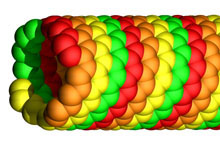Home > Press > Nanotube's 'tapestry' controls its growth: PNAS study answers longstanding mystery about carbon nanomaterials
 |
Abstract:
Rice University materials scientists have put a new "twist" on carbon nanotube growth. The researchers found nanotubes grow like tiny molecular tapestries, woven from twisting, single-atom threads. The research appears online this week in the Proceedings of the National Academy of Sciences and finds a direct relationship between a nanotube's "chiral" angle -- the amount it's twisted -- and how fast it grows.
Nanotube's 'tapestry' controls its growth: PNAS study answers longstanding mystery about carbon nanomaterials
Houston, TX | Posted on February 5th, 2009Carbon nanotubes are hollow tubes of pure carbon that measure about one nanometer, or one-billionth of a meter, in diameter. In molecular diagrams, they look like rolled-up sheets of chicken wire. And just like a roll of wire or gift-wrapping paper, nanotubes can be rolled at an odd angle with excess hanging off the end.
Though nanotubes are much-studied, their growth is poorly understood. They grow by "self assembly," forming spontaneously from gaseous carbon feedstock under precise catalytic circumstances. The new research, which appears online this week in the Proceedings of the National Academy of Sciences, finds a direct relationship between a nanotube's "chiral" angle -- the amount it's twisted -- and how fast it grows.
"Our study offers some clues about this intimate 'self assembly' process," said Rice's Boris Yakobson, professor in mechanical engineering and materials science and of chemistry. New theory suggests that each tube is 'woven' from many twisting threads. Each grows independently, with new atoms attaching themselves to the exposed thread ends. The more threads there are, the faster the whole tapestry grows.
Yakobson, the lead researcher on the project, said the new formula's predictions have been borne out by a number of laboratory reports. For example, the formula predicts that nanotubes with the largest chiral angle will grow fastest because they have the most exposed threads -- something that's been shown in several experiments.
"Chirality is one of the primary determinants of a nanotube's properties," said Yakobson. "Our approach reveals quantitatively the role that chirality plays in growth, which is of great interest to all who hope to incorporate nanotubes into new technologies."
The study was co-authored by former Rice research scientist Feng Ding, now assistant professor at Hong Kong Polytechnic University, and Avetik Harutyunyan of the Honda Research Institute USA in Columbus, Ohio. The research was supported by the National Science Foundation, the Welch Foundation and the Department of Defense.
####
About Rice University
Located in Houston, Rice University is consistently ranked one of America's best teaching and research universities. Known for its "unconventional wisdom," Rice is distinguished by its: size -- 3,001 undergraduates and 2,144 graduate students; selectivity -- 12 applicants for each place in the freshman class; resources -- an undergraduate student-to-faculty ratio of 5-to-1; sixth largest endowment per student among American private research universities; residential college system, which builds communities that are both close-knit and diverse; and collaborative culture, which crosses disciplines, integrates teaching and research, and intermingles undergraduate and graduate work.
For more information, please click here
Contacts:
Jade Boyd
Associate Director and Science Editor
Office of Public Affairs/News & Media Relations
Rice University
(office) 713-348-6778
(cell) 713-302-2447
Copyright © Rice University
If you have a comment, please Contact us.Issuers of news releases, not 7th Wave, Inc. or Nanotechnology Now, are solely responsible for the accuracy of the content.
| Related News Press |
News and information
![]() Researchers develop molecular qubits that communicate at telecom frequencies October 3rd, 2025
Researchers develop molecular qubits that communicate at telecom frequencies October 3rd, 2025
![]() Next-generation quantum communication October 3rd, 2025
Next-generation quantum communication October 3rd, 2025
![]() "Nanoreactor" cage uses visible light for catalytic and ultra-selective cross-cycloadditions October 3rd, 2025
"Nanoreactor" cage uses visible light for catalytic and ultra-selective cross-cycloadditions October 3rd, 2025
Nanotubes/Buckyballs/Fullerenes/Nanorods/Nanostrings
![]() Enhancing power factor of p- and n-type single-walled carbon nanotubes April 25th, 2025
Enhancing power factor of p- and n-type single-walled carbon nanotubes April 25th, 2025
![]() Chainmail-like material could be the future of armor: First 2D mechanically interlocked polymer exhibits exceptional flexibility and strength January 17th, 2025
Chainmail-like material could be the future of armor: First 2D mechanically interlocked polymer exhibits exceptional flexibility and strength January 17th, 2025
![]() Innovative biomimetic superhydrophobic coating combines repair and buffering properties for superior anti-erosion December 13th, 2024
Innovative biomimetic superhydrophobic coating combines repair and buffering properties for superior anti-erosion December 13th, 2024
Discoveries
![]() Researchers develop molecular qubits that communicate at telecom frequencies October 3rd, 2025
Researchers develop molecular qubits that communicate at telecom frequencies October 3rd, 2025
![]() Next-generation quantum communication October 3rd, 2025
Next-generation quantum communication October 3rd, 2025
![]() "Nanoreactor" cage uses visible light for catalytic and ultra-selective cross-cycloadditions October 3rd, 2025
"Nanoreactor" cage uses visible light for catalytic and ultra-selective cross-cycloadditions October 3rd, 2025
Announcements
![]() Rice membrane extracts lithium from brines with greater speed, less waste October 3rd, 2025
Rice membrane extracts lithium from brines with greater speed, less waste October 3rd, 2025
![]() Researchers develop molecular qubits that communicate at telecom frequencies October 3rd, 2025
Researchers develop molecular qubits that communicate at telecom frequencies October 3rd, 2025
![]() Next-generation quantum communication October 3rd, 2025
Next-generation quantum communication October 3rd, 2025
![]() "Nanoreactor" cage uses visible light for catalytic and ultra-selective cross-cycloadditions October 3rd, 2025
"Nanoreactor" cage uses visible light for catalytic and ultra-selective cross-cycloadditions October 3rd, 2025
|
|
||
|
|
||
| The latest news from around the world, FREE | ||
|
|
||
|
|
||
| Premium Products | ||
|
|
||
|
Only the news you want to read!
Learn More |
||
|
|
||
|
Full-service, expert consulting
Learn More |
||
|
|
||








